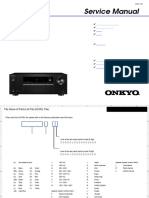Kafka Producer Apis: Find Answers On The Fly, or Master Something New. Subscribe Today
Uploaded by
Dallas GuyKafka Producer Apis: Find Answers On The Fly, or Master Something New. Subscribe Today
Uploaded by
Dallas GuyPREV NEXT
⏮ Kafka producer internals Building Data Streaming Applications with Apache Kafka Producer object and ProducerRecord object ⏭
Kafka Producer APIs
Kafka has provided you with a rich set of APIs to create applications to interact with it. We will go through
Producer API details and understand its uses.
Creating a Kafka producer involves the following steps:
1. Required configuration.
2. Creating a producer object.
3. Setting up a producer record.
4. Creating a custom partition if required.
5. Additional configuration.
Required configuration: In most applications, we first start with creating the initial configuration without which
we cannot run the application. The following are three mandatory configuration parameters:
bootstrap.servers: This contains a list of Kafka brokers addresses. The address is specified in terms of
hostname:port. We can specify one or more broker detail, but we recommend that you provide at least two so that
if one broker goes down, producer can use the other one.
Find answers on the fly, or master something new. Subscribe today. See pricing options.
It is not necessary to specify all brokers as the Kafka producer queries this configured broker for
information about other brokers. In older versions of Kafka, this property was metadata.broker.list, where
we used to specify a list of brokers host:port.
key.serializer: The message is sent to Kafka brokers in the form of a key-value pair. Brokers expect this key-
value to be in byte arrays. So we need to tell producer which serializer class is to be used to convert this key-
value object to a byte array. This property is set to tell the producer which class to use to serialize the key of
the message.
Kafka provides us with three inbuilt serializer classes: ByteArraySerializer, StringSerializer, and
IntegerSerializer. All these classes are present in the org.apache.kafka.common.serialization package and
implement the serializer interface.
value.serializer: This is similar to the key.serializer property, but this property tells the producer which class to
use in order to serialize the value. You can implement your own serialize class and assign to this property.
Let's see how we do it in a programming context.
Here is how Java works for Producer APIs:
Properties producerProps = new Properties();
producerProps.put("bootstrap.servers", "broker1:port,broker2:port");
producerProps.put("key.serializer",
"org.apache.kafka.common.serialization.StringSerializer");
producerProps.put("value.serializer",
"org.apache.kafka.common.serialization.StringSerializer");
KafkaProducer<String, String> producer = new KafkaProducer<String,String>(producerProps);
The Producer API in Scala:
val producerProps = new Properties()
producerProps.put("bootstrap.servers", "broker1:port,broker2:port");
producerProps.put("key.serializer", "org.apache.kafka.common.serialization.Str
producerProps.put("value.serializer", "org.apache.kafka.common.serialization.Strin
val producer = new KafkaProducer[String, String](producerProps)
The preceding code contains three specific points:
Properties object: We start with creating a property object; this object contains the put method that is used to
put the configuration key-value pair in place
Serializer class: We will use StringSerializer for both key and value as our key and value will be of the string
type
Producer object: We create a producer object by passing the configuration object to it, which provides the
producer with specific information about broker servers, serializer classes, and other configurations that we
will see later
Support / Sign Out
© 2021 O'Reilly Media, Inc. Terms of Service / Privacy Policy
You might also like
- Mac Pro (Mid 2010:mid 2012) - Apple Technician Guide - Rev 2012-06-11No ratings yetMac Pro (Mid 2010:mid 2012) - Apple Technician Guide - Rev 2012-06-11226 pages
- SDM-1 Mini Manual: Page 1 of 54 426006-2101-013-A0No ratings yetSDM-1 Mini Manual: Page 1 of 54 426006-2101-013-A054 pages
- Kafka Producer Internals: Find Answers On The Fly, or Master Something New. Subscribe TodayNo ratings yetKafka Producer Internals: Find Answers On The Fly, or Master Something New. Subscribe Today1 page
- Event-Driven Architecture- Building Scalable Systems With Apache Kafka - The TalNo ratings yetEvent-Driven Architecture- Building Scalable Systems With Apache Kafka - The Tal19 pages
- Kafka Integration Made Easy with Spring Boot _ by Avinash Hargun _ Simform Engineering _ MediumNo ratings yetKafka Integration Made Easy with Spring Boot _ by Avinash Hargun _ Simform Engineering _ Medium19 pages
- Producing Messages With Kafka Producers: Ryan PlantNo ratings yetProducing Messages With Kafka Producers: Ryan Plant31 pages
- Advanced Apache Kafka: Engineering High-Performance Streaming ApplicationsFrom EverandAdvanced Apache Kafka: Engineering High-Performance Streaming ApplicationsNo ratings yet
- Getting Started With Apache Kafka in Python - Towards Data Science PDFNo ratings yetGetting Started With Apache Kafka in Python - Towards Data Science PDF17 pages
- How To Install Apache Kafka On Ubuntu 20.04 DigitalOceanNo ratings yetHow To Install Apache Kafka On Ubuntu 20.04 DigitalOcean12 pages
- Apache KAFKA - Training Contents - 5 DaysNo ratings yetApache KAFKA - Training Contents - 5 Days2 pages
- Getting To Know Kafka: Ola Is The First Course in The Series of Courses Covering All The Aspects of KafkaNo ratings yetGetting To Know Kafka: Ola Is The First Course in The Series of Courses Covering All The Aspects of Kafka23 pages
- 01 - Chapter Introduction To AMQ StreamsNo ratings yet01 - Chapter Introduction To AMQ Streams10 pages
- Apache Kafka Confluent Enterprise Ref ArchitectureNo ratings yetApache Kafka Confluent Enterprise Ref Architecture17 pages
- Welcome Introduction To Pixer: NavigationNo ratings yetWelcome Introduction To Pixer: Navigation144 pages
- Getting To Know Apache Kafka's Architecture: Ryan PlantNo ratings yetGetting To Know Apache Kafka's Architecture: Ryan Plant23 pages
- Introduction To Apache Ka Ka For Python Programmers: InstallationNo ratings yetIntroduction To Apache Ka Ka For Python Programmers: Installation8 pages
- Amazon Managed Streaming For Apache KafkaNo ratings yetAmazon Managed Streaming For Apache Kafka11 pages
- Confluent Platform Reference Architecture KubernetesNo ratings yetConfluent Platform Reference Architecture Kubernetes10 pages
- Building and Deploying An Application To Multiple ClustersNo ratings yetBuilding and Deploying An Application To Multiple Clusters31 pages
- OpenText Activator For SAP Solutions 10.0.0 - Programming Guide English (LLESSAP100000-PGD-EN-1)No ratings yetOpenText Activator For SAP Solutions 10.0.0 - Programming Guide English (LLESSAP100000-PGD-EN-1)23 pages
- Kafka's Architecture: Find Answers On The Fly, or Master Something New. Subscribe TodayNo ratings yetKafka's Architecture: Find Answers On The Fly, or Master Something New. Subscribe Today1 page
- Message Partitions: Find Answers On The Fly, or Master Something New. Subscribe TodayNo ratings yetMessage Partitions: Find Answers On The Fly, or Master Something New. Subscribe Today1 page
- Custom Partition - Building Data Streaming Applications With Apache KafkaNo ratings yetCustom Partition - Building Data Streaming Applications With Apache Kafka1 page
- Best Practices: Find Answers On The Fly, or Master Something New. Subscribe TodayNo ratings yetBest Practices: Find Answers On The Fly, or Master Something New. Subscribe Today1 page
- Conventions - Building Data Streaming Applications With Apache KafkaNo ratings yetConventions - Building Data Streaming Applications With Apache Kafka1 page
- Advance Queuing Messaging Protocol - Building Data Streaming Applications With Apache KafkaNo ratings yetAdvance Queuing Messaging Protocol - Building Data Streaming Applications With Apache Kafka1 page
- Additional Producer Configuration: Find Answers On The Fly, or Master Something New. Subscribe TodayNo ratings yetAdditional Producer Configuration: Find Answers On The Fly, or Master Something New. Subscribe Today1 page
- 4125I/4125 Side Scan Sonar System: User Hardware ManualNo ratings yet4125I/4125 Side Scan Sonar System: User Hardware Manual142 pages
- Water-Level Controller: Joydeep Kumar ChakrabortyNo ratings yetWater-Level Controller: Joydeep Kumar Chakraborty3 pages
- Ac Motor Speed Control Using PWM Technique100% (1)Ac Motor Speed Control Using PWM Technique63 pages
- Exact Event Manager 1.8 Installation ManualNo ratings yetExact Event Manager 1.8 Installation Manual30 pages
- Slides Lambda Expressions Functional Interfaces and Method References Java's Functional Interfaces Consumer & PredicateNo ratings yetSlides Lambda Expressions Functional Interfaces and Method References Java's Functional Interfaces Consumer & Predicate6 pages
- Custom Windows 10 ISO Image Instructions Using Virtual MachineNo ratings yetCustom Windows 10 ISO Image Instructions Using Virtual Machine2 pages
- Thesis Ii Progress Report: Edgardo Bedrijo Jr. Mario Borromeo Jr. Genel Pornillos Jestoni ImperialNo ratings yetThesis Ii Progress Report: Edgardo Bedrijo Jr. Mario Borromeo Jr. Genel Pornillos Jestoni Imperial2 pages
- Mini Project Phase 1 Seminar PPT TemplateNo ratings yetMini Project Phase 1 Seminar PPT Template13 pages
- FOUNDATION Fieldbus Communication Protocol - Everything You Need To Know - VisayaNo ratings yetFOUNDATION Fieldbus Communication Protocol - Everything You Need To Know - Visaya10 pages
- Poweredge-C5230 - Owner's Manual - En-Us PDFNo ratings yetPoweredge-C5230 - Owner's Manual - En-Us PDF146 pages
- Multi Level, Multi Transition & Block CodesNo ratings yetMulti Level, Multi Transition & Block Codes31 pages
































































































